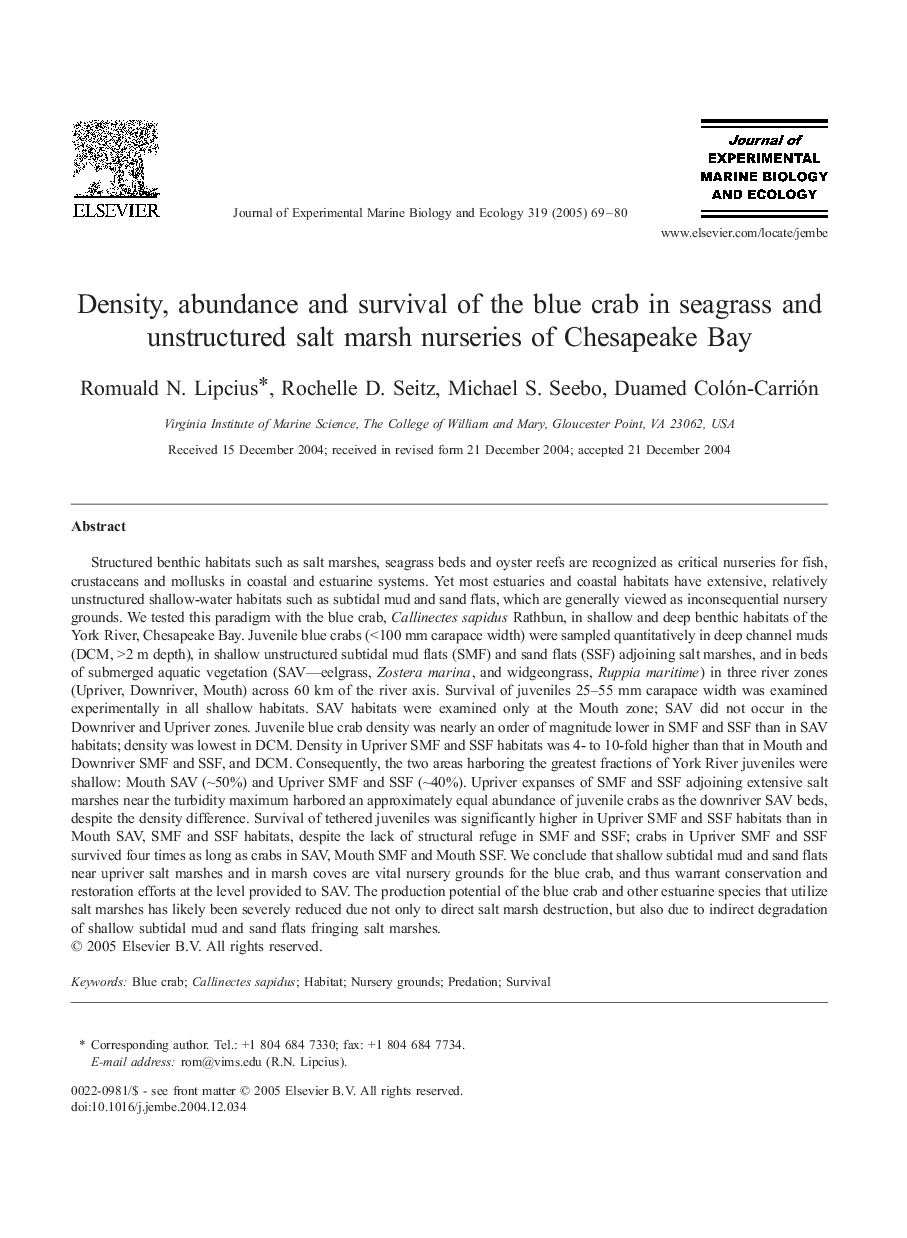| کد مقاله | کد نشریه | سال انتشار | مقاله انگلیسی | نسخه تمام متن |
|---|---|---|---|---|
| 9448764 | 1618495 | 2005 | 12 صفحه PDF | دانلود رایگان |
عنوان انگلیسی مقاله ISI
Density, abundance and survival of the blue crab in seagrass and unstructured salt marsh nurseries of Chesapeake Bay
دانلود مقاله + سفارش ترجمه
دانلود مقاله ISI انگلیسی
رایگان برای ایرانیان
کلمات کلیدی
موضوعات مرتبط
علوم زیستی و بیوفناوری
علوم کشاورزی و بیولوژیک
علوم آبزیان
پیش نمایش صفحه اول مقاله

چکیده انگلیسی
Structured benthic habitats such as salt marshes, seagrass beds and oyster reefs are recognized as critical nurseries for fish, crustaceans and mollusks in coastal and estuarine systems. Yet most estuaries and coastal habitats have extensive, relatively unstructured shallow-water habitats such as subtidal mud and sand flats, which are generally viewed as inconsequential nursery grounds. We tested this paradigm with the blue crab, Callinectes sapidus Rathbun, in shallow and deep benthic habitats of the York River, Chesapeake Bay. Juvenile blue crabs (<100 mm carapace width) were sampled quantitatively in deep channel muds (DCM, >2 m depth), in shallow unstructured subtidal mud flats (SMF) and sand flats (SSF) adjoining salt marshes, and in beds of submerged aquatic vegetation (SAV-eelgrass, Zostera marina, and widgeongrass, Ruppia maritime) in three river zones (Upriver, Downriver, Mouth) across 60 km of the river axis. Survival of juveniles 25-55 mm carapace width was examined experimentally in all shallow habitats. SAV habitats were examined only at the Mouth zone; SAV did not occur in the Downriver and Upriver zones. Juvenile blue crab density was nearly an order of magnitude lower in SMF and SSF than in SAV habitats; density was lowest in DCM. Density in Upriver SMF and SSF habitats was 4- to 10-fold higher than that in Mouth and Downriver SMF and SSF, and DCM. Consequently, the two areas harboring the greatest fractions of York River juveniles were shallow: Mouth SAV (â¼50%) and Upriver SMF and SSF (â¼40%). Upriver expanses of SMF and SSF adjoining extensive salt marshes near the turbidity maximum harbored an approximately equal abundance of juvenile crabs as the downriver SAV beds, despite the density difference. Survival of tethered juveniles was significantly higher in Upriver SMF and SSF habitats than in Mouth SAV, SMF and SSF habitats, despite the lack of structural refuge in SMF and SSF; crabs in Upriver SMF and SSF survived four times as long as crabs in SAV, Mouth SMF and Mouth SSF. We conclude that shallow subtidal mud and sand flats near upriver salt marshes and in marsh coves are vital nursery grounds for the blue crab, and thus warrant conservation and restoration efforts at the level provided to SAV. The production potential of the blue crab and other estuarine species that utilize salt marshes has likely been severely reduced due not only to direct salt marsh destruction, but also due to indirect degradation of shallow subtidal mud and sand flats fringing salt marshes.
ناشر
Database: Elsevier - ScienceDirect (ساینس دایرکت)
Journal: Journal of Experimental Marine Biology and Ecology - Volume 319, Issues 1â2, 1 June 2005, Pages 69-80
Journal: Journal of Experimental Marine Biology and Ecology - Volume 319, Issues 1â2, 1 June 2005, Pages 69-80
نویسندگان
Romuald N. Lipcius, Rochelle D. Seitz, Michael S. Seebo, Duamed Colón-Carrión,